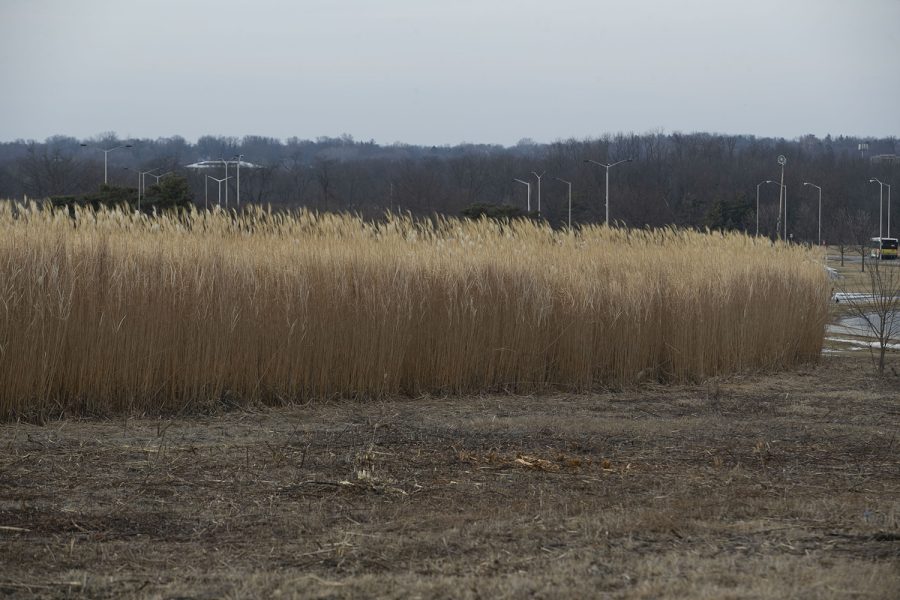UI among top universities in using sustainable energy
The University of Iowa was recently recognized by the Environmental Protection Agency on several lists of the largest green power users in the country.
A miscanthus grass field is seen west from downtown Iowa City on Melrose Ave on Tuesday, Feb. 15, 2022.
February 16, 2022
The University of Iowa was recognized as one of the top institutions in the country in using sustainable energy by the U.S. Environmental Protection Agency.
The UI is listed on several of the EPA’s Green Power Partner users rankings from last month, including the top 30 colleges and universities, as well as the top 30 on-site generation locations.
The UI ranks third and 26th nationally among the top universities for on-site generations and is the highest-ranking Big Ten school on the top 30 colleges and universities list.
The biomass program at the UI started in 2003 when the university’s power plant started to use leftover oat hulls from the Quaker Oats mill in Cedar Rapids to produce steam.
Before the biomass program, the university’s utilities operated solely on burning coal and natural gas, said Stratis Giannakouros, director of the UI’s Office of Sustainability and the Environment.
During this time, Giannakouros said, the university was forced to make a decision on how utilities would be powered in the future.
“Our choices were to continue to burn coal, switch over completely to natural gas, or a third path, that was very entrepreneurial and innovative, and that was to figure out how to burn biomass in our in our boilers,” Giannakouros said.
The university succeeded in reverse engineering these boilers to run on biomass fuels, as well as experimenting with other coal alternatives, such as miscanthus grass and energy pellets.
Because the UI used these biomass fuels, Giannakouros said the university’s coal usage is down 87 percent from what it was before the biomass program began and said the UI is on track to be zero coal by 2023, which is sooner than the intended date of 2025.
The combined green power usage from the universities included on the list is equivalent to the annual electricity use of nearly 362,000 average American homes, according to the EPA.
Established in 2001, The EPA’s Green Power Partnership is a federal program that works with U.S.- based organizations and institutions to encourage the purchase of green power to reduce the emissions associated with electricity use.
Ben Fish, UI director of Utilities Operations, said it’s validating that the university is recognized in these rankings after all the hard work staff has done.
“We realize there’s still a lot of work to do, and we need to keep pushing,” he said. “Recognition like this tells us we’re on the right track and it gives us confidence in the direction we’re going.”
The UI has had a partnership with the EPA since 2007, Fish said.
Giannakouros said the UI could have followed down the path that other universities have gone and replaced coal with natural gas since they are designed for the boilers.
“We think natural gas is an inferior climate solution to coal, so our commitment is to make [biomass fuels] work, but it’s really challenging,” he said. “You’re repurposing boilers that were not designed to burn biomass, and it requires a lot of novel engineering solutions and staff expertise.”
Giannakouros said 24 percent of the university’s fuel mix is natural gas.
Libbie Smith, UI Undergraduate Student Government director of sustainability, said she thinks the UI Office of Sustainability has done great work, but she would like to see the university eventually evolve past biomass.
“Biomass is definitely better than coal, but it’s not as great as wind or solar energy,” she said. “I know the difficulties of getting that infrastructure in, especially in Iowa, but I want to see a much more strong commitment towards sustainable energy actually happen.”
Fish said making keeping campus running while simultaneously transitioning from coal has been a challenge.
“The biggest hurdle in going to renewable alternatives off of coal is that you have to make that transition while still trying to power a university campus that absolutely has to have power to run,” he said.
Fish said the price of biomass fuels is similar to what the UI was already spending on coal and said that the prices of these fuels are more stable.
“There’s a price risk with natural gas that we essentially offset with these other fuels that we’re using,” Fish said.















